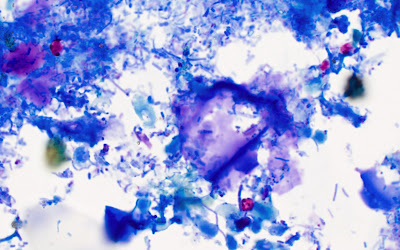This week's case is from a 4 year old boy with sudden onset of 'explosive' watery diarrhea, accompanied by low grade fever, nausea, vomiting, and loss of appetite. A stool specimen was obtained after 1 week of symptoms, and the following objects were noted on a modified acid fast stain. They measure approximately 5 micrometers in diameter.
Here are some questions to consider:
1. What parasite is shown?
2. Name 3 common ways that infection is acquired.
3. What is the typical recommended treatment?
4. What are the risk factors for severe infection.
As with last week, Hadel Go is serving as a guest author, and will help us answer these questions later this week. Stay tuned!



1. Cryptosporidium spp. Cannot tell the species by morphology but statistically more likely to be C. hominid than C. parvum
ReplyDelete2. Fecal-oral transmission through contaminated water, food, or close contact with an infected individual.
3. Only FDA approved treatment is nitazoxanide. Far from optimal as therapy.
4. Risk factors for severe infection include AIDS, other severe immunocompromising conditions, and moderate to severe acute malnutrition.
Agreed
DeleteFor sure they are oocysts of Cryptosporidium species. Per EID articles there is a great number of animal sources which may cause diarrhea in man and contaminated food or water are the port of entry. The severity of the infection is more pronounced in AIDS patients or immunocompromised patients. Though these oocysts fluoresce brightly with their corresponding DFA, the one caveat is that they may not fluoresce at times and though they only stain variably acid fast, this methodology still remains a great diagnostic tool. A direct examination of the stool concentrate with 1% eosin in saline helps greatly detect the oocysts by their green refringence.
ReplyDeleteFlorida Fan
The images are suggestive of Cryptosporidium spp. The patient should have acquired through faecal contamination of either food especially fruits or water. Can also be seen in immucomprised individuals
ReplyDeleteThis is cryposporidum either found in immnocompromised patients or contaminated food from unsafe farm place, I was playing with a lot of immune compromised patients to get the experience when I found about this parasites back home in my own lab.
ReplyDeleteNice case with beautiful pictures! Although modified acid-fast staining remains the standard for detecting crystosporidiosis, I prefer the negative carbolfuchsine staining myself (for screening). Also of note: although all coccidia are autofluorescent, Cryptosporidium sp. is NOT autofluorescent.
ReplyDeleteWith regard to Hadel's questions:
1. Oocysts of Cryptosporidium sp. - could be any species, but is most often C. hominis (anthroponotic) or C. parvum (zoonotic). Rarely other zoonotic species are found in humans (e.g. C.meleagridis).
2. I'd say : water, water and water... :-D
Feco-oral through a)contaminated food, b) contaminated drinking water or swimming pools (chlorination does not kill these oocysts!), c) close contact with infected animals (e.g. petting zoo).
For a cool outbreak story: https://www.nejm.org/doi/10.1056/NEJM199407213310304
For the outbreak associated costs for society: https://wwwnc.cdc.gov/eid/article/9/4/02-0417_article
3. No optimal treatment exists for these tough little critters! The message is: "Drink!" to avoid dehydration. FDA-approved Nitazoxanide is available for immunocompetent persons. Efficacy in immunocompromised patients is not yet clear though. For patients with HIV, anti-retroviral therapy (to improve immune status) could resolve the symptoms.
4. Immunocompromised people are at risk for severe cryptosporidiosis.
I totally agree with idzi P.
ReplyDelete